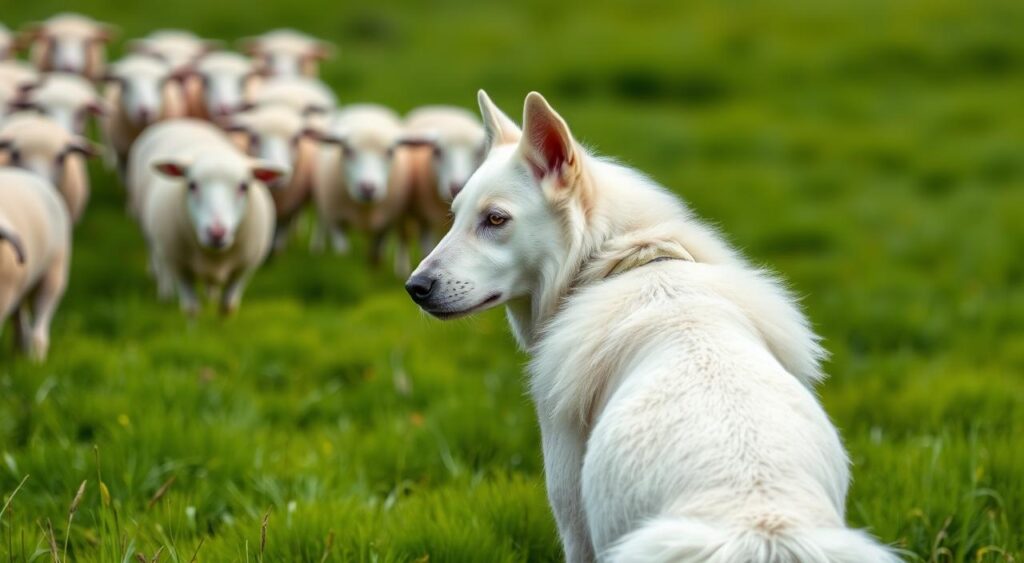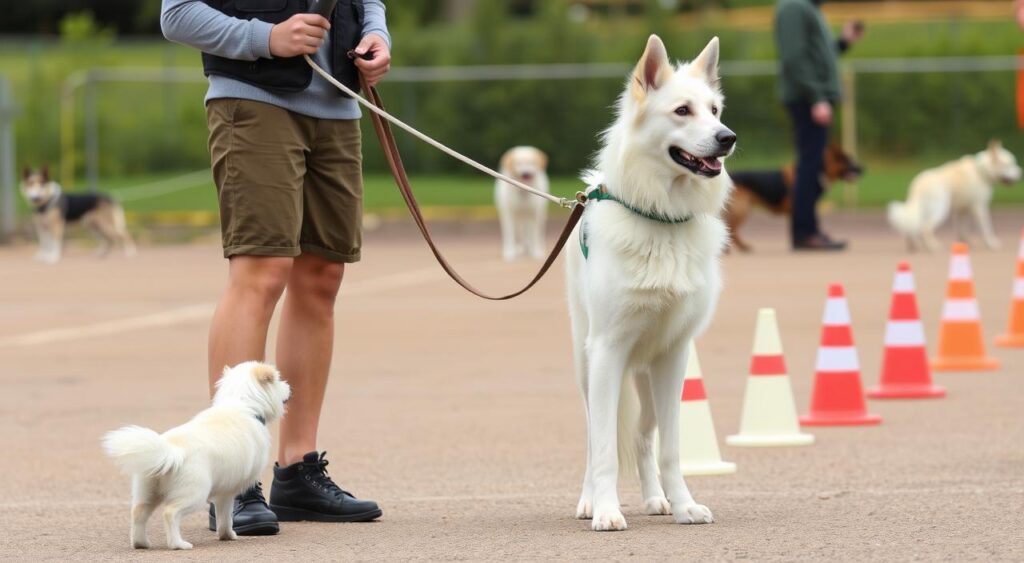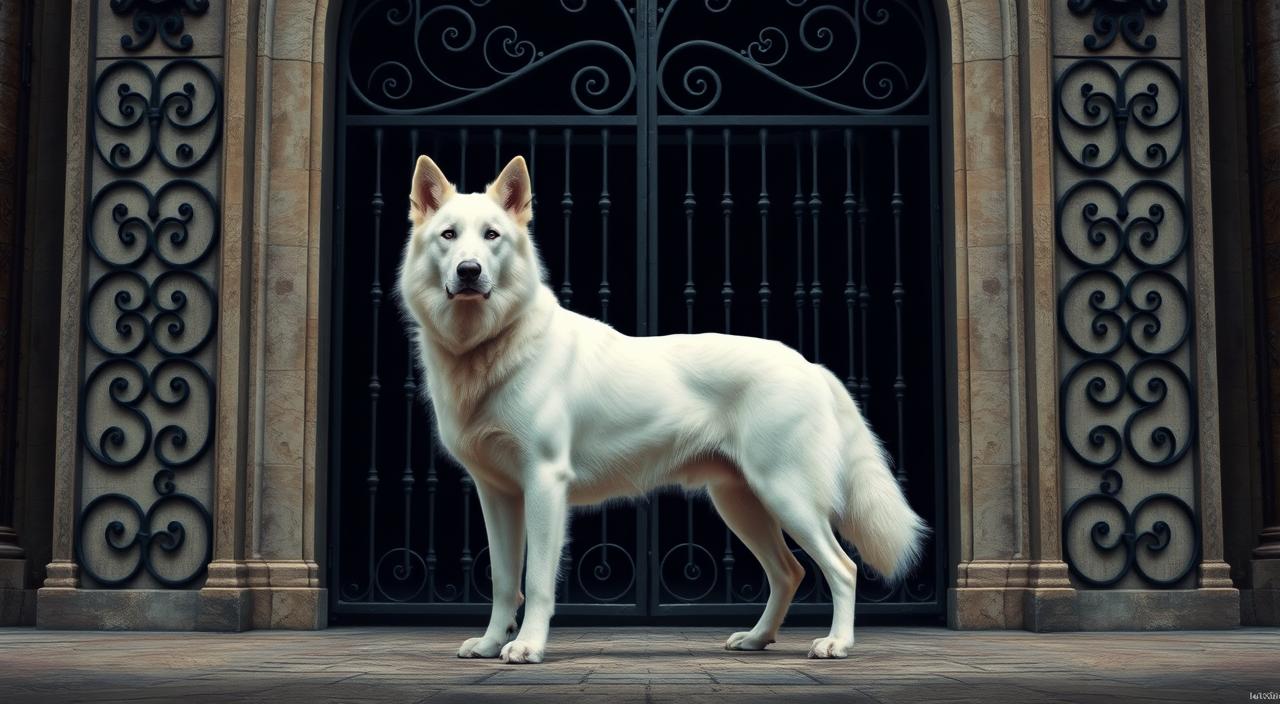White Shepherds are the third smartest dog breed. Their intelligence makes them perfect for families and working roles. These dogs stand out with their keen minds and striking looks.
White Shepherds are a German Shepherd variant. They weigh 65 to 110 pounds, combining brains and brawn. Their size and smarts suit them for various tasks, including herding and rescue work.
These dogs excel as loyal companions and alert guardians. Their intelligence makes training a breeze for experienced owners. White Shepherds fit well as family pets or working dogs.
White Shepherds need 1½ hours of daily exercise. They’re always ready for new adventures or tasks. These dogs love long walks and complex training sessions.
Their energy and smarts keep them eager for activity. White Shepherds thrive on physical and mental challenges. This makes them ideal for active owners.
The Origins of the White Shepherd
The White Shepherd’s ancestry links to the German Shepherd breed. This purebred working dog shares traits with its darker-coated relatives. In 1917, a litter of four white puppies marked the breed’s U.S. debut.
H.N. Hanchett brought the first White German Shepherd from Germany to the USA in 1920. These dogs kept German Shepherd traits like intelligence and strong working abilities. The breed evolved, keeping classic features while showcasing a unique white coat.
The White Shepherd’s path to recognition has been slow but steady. In 1999, the United Kennel Club (UKC) acknowledged it as a distinct breed in the U.S.
The FCI granted provisional status in 2002. On July 4, 2011, they formally accepted the White Swiss Shepherd breed.
| Organization | Recognition Status | Year |
|---|---|---|
| United Kennel Club (UKC) | Recognized as distinct breed | 1999 |
| FCI | Provisional breed status | 2002 |
| FCI | Formal acceptance | 2011 |
| American Kennel Club (AKC) | Not recognized | Since 1968 |
The White Shepherd remains a versatile herding dog and loyal companion. Its unique look and working dog traits make it a popular choice. Many seek this intelligent and capable canine partner.
Physical Characteristics of the White Shepherd
The White Shepherd is a stunning dog with a unique white coat. It has a strong, muscular build similar to German Shepherds. Let’s explore the key features that make this breed special.
Size and Weight
White Shepherds are medium to large dogs. Males stand 24-26 inches tall, while females reach 22-24 inches. Male dogs weigh 77-88 pounds, and females range from 71-77 pounds.

Coat Color and Texture
This breed’s main feature is its pure white coat. The coat is usually dense and straight. White Shepherds shed moderately all year, with heavier shedding twice yearly.
Regular brushing helps manage their coat and keeps it looking clean.
Distinctive Features
White Shepherds look a lot like German Shepherds. They have pointed ears, alert expressions, and strong, athletic bodies. Their white coat makes them stand out and look regal.
| Feature | Description |
|---|---|
| Ears | Erect and pointed |
| Eyes | Almond-shaped, expressive |
| Tail | Long, slightly curved |
| Body | Strong, muscular build |
These traits create a dog that’s both beautiful and useful. White Shepherds look like working dogs. They can herd, guard, and be loyal companions.
Temperament and Personality Traits
White Shepherds are loyal companions and guardian dogs. They have a unique blend of qualities. These intelligent canines have a fearless expression and confident demeanor.
As working dogs, they’re eager to serve. They stay alert to their surroundings. White Shepherds are protective yet approachable.

They stand their ground without aggression. This makes them ideal family pets. When socialized, they’re gentle with children.
White Shepherds are playful and curious. They may whine, grunt, and moan to express themselves. Their temperament is milder than darker-colored shepherds.
“White Shepherds have a unique blend of loyalty, protection, and gentleness that makes them outstanding companions for families.”
Early training shapes a White Shepherd’s behavior. It prevents issues and builds confidence. With guidance, they grow into well-rounded adults.
- Eager to serve and alert
- Approachable and confident
- Protective yet gentle with children
- Playful and curious nature
- Milder temperament compared to other shepherd varieties
White Shepherds have a balanced temperament. They’re versatile and capable. These dogs excel in roles from family companions to search and rescue work.
White Shepherd: A Versatile Working Dog
White Shepherds excel in various roles as valuable working dogs. Their intelligence and strong work ethic come from their German Shepherd lineage. These traits allow them to adapt easily to different tasks.
Herding Abilities
The White Shepherd shines as a herding dog. Their natural instincts and attentiveness make them perfect for managing livestock. These dogs can effortlessly control and guide herds.

Guard Dog Capabilities
White Shepherds are excellent guard dogs. They can accurately assess threats and protect properties and families. As livestock guardians, they provide reliable protection against predators.
Search and Rescue Potential
White Shepherds are well-suited for search and rescue operations. Their keen sense of smell helps them excel in locating missing persons. Their endurance and agility allow them to work in various terrains.
The American White Shepherd Association (AWSA) and White Shepherd Club of Canada (WSCC) recognize the breed’s versatility. The United Kennel Club (UKC) officially acknowledged the White Shepherd as a distinct breed in 1999.
| Working Role | Key Traits |
|---|---|
| Herding | Natural instincts, attentiveness |
| Guarding | Protective nature, threat assessment |
| Search and Rescue | Intelligence, physical capabilities |
White Shepherds’ adaptability and strong work ethic make them invaluable in many roles. They excel in herding, guarding, and search and rescue operations.
Training and Socialization Requirements
White Shepherds are smart dogs that need regular training and early socialization. They love mental challenges and clear rules. Good training helps these dogs become great companions.
These shepherds thrive on mental work and need clear boundaries. Proper training ensures they grow into well-behaved and trustworthy pets.

Nadia Adams, a German Shepherd breeder, stresses early training importance. White Shepherds have a key socialization window that ends at 12-16 weeks. During this time, expose your puppy to various people, animals, and places.
This exposure builds confidence and prevents future behavior problems. White Shepherds excel in obedience training due to their strong work ethic. Start with basic commands and slowly increase difficulty.
Use impulse control exercises to curb problem behaviors. Keep training sessions short, about 15-30 minutes. Use positive reinforcement techniques for best results.
“A properly bred German Shepherd Dog is highly intelligent and trainable,” says Adams. “Consistent training and socialization are key to raising a well-adjusted White Shepherd.”
Crate training helps reduce separation anxiety in White Shepherd puppies. These dogs are usually easy to housetrain, but patience is key. White Shepherds may not fully mature until two or three years old.
Males typically mature later than females. Remember, consistency and positive reinforcement are crucial for successful training.
| Training Aspect | Recommendation |
|---|---|
| Daily Exercise | 60-90 minutes |
| Training Session Duration | 15-30 minutes |
| Socialization Period | Up to 16 weeks |
| Full Maturity Age | 2-3 years |
Exercise Needs and Activity Level
White Shepherds are energetic dogs that need lots of physical and mental exercise. These working dogs require daily activity to stay healthy and happy.
Without enough exercise, White Shepherds may become bored and destructive. Regular activity helps them maintain a balanced temperament.
Daily Exercise Recommendations
White Shepherds need at least 60 minutes of exercise daily. This can be split into two walks.
As part of the Herding Group, they typically need 60-120 minutes of daily activity. Aim for 60-90 minutes of vigorous exercise for optimal health.
Hiking, swimming, and fetch are great activities for these energetic dogs. Adjust exercise routines for puppies, senior dogs, or those with health issues.
Mental Stimulation Activities
Mental exercise is as important as physical activity for this smart working dog. Keep your White Shepherd engaged with various activities.
- Obedience training
- Puzzle toys
- Hide-and-seek games
- Agility courses
These activities prevent boredom and boost overall well-being. Indoor exercises can keep your dog active during bad weather.
| Activity Type | Duration | Frequency |
|---|---|---|
| Walks | 30 minutes | Twice daily |
| Intense play | 15-30 minutes | Once daily |
| Mental stimulation | 15-20 minutes | 2-3 times daily |
White Shepherds as Family Pets
White Shepherds make excellent family pets. They blend loyalty and guardianship seamlessly. These dogs form strong bonds with their families, often picking a favorite person.
Their gentle nature suits children perfectly. They display patience and protectiveness in equal measure. White Shepherds excel at keeping their loved ones safe.
These dogs show impressive intelligence. They accurately assess situations, remaining trustworthy around family members. Their protective instinct makes them excellent guardians.
White Shepherds may be cautious with strangers. Early socialization helps them feel confident in new situations. They need daily mental and physical stimulation.
Long walks and engaging activities are essential. Agility training or advanced obedience classes can keep them happy. These dogs thrive on challenges and family interaction.
| Characteristic | Description |
|---|---|
| Temperament | Gentle, playful, protective |
| Family Compatibility | Excellent with children |
| Exercise Needs | High (daily long walks) |
| Training | Highly intelligent, easily trainable |
| Grooming | Regular, due to heavy shedding |
Owning a White Shepherd requires commitment. Their heavy shedding demands regular grooming. Some areas have restrictions due to their guardian dog appearance.
Despite challenges, many families adore White Shepherds. They bring energy, playfulness, and unwavering loyalty to homes. For many, they’re the ultimate canine companions.
Health Concerns and Lifespan
White Shepherds face several health challenges. Owners can provide better care by understanding these issues. This knowledge helps ensure a happy, healthy life for these beloved dogs.
Common Health Issues
Hip dysplasia affects over 17% of White Shepherds. Elbow dysplasia rates stand at 19%. These rates are slightly better than their German Shepherd counterparts.
Other concerns include degenerative myelopathy and eye diseases. Skin problems, autoimmune diseases, and neurological issues also affect this breed. Digestive diseases, heart problems, cancer, epilepsy, and bloat are additional health risks.
Preventative Care
Regular vet check-ups are crucial for White Shepherds. Proper diet and exercise help maintain their health. 71% of White Shepherds receive training or join events, boosting their well-being.
Expected Lifespan
White Shepherds live an average of 12 years. Genetics, diet, and exercise influence their longevity. Studies show the average age of White Shepherds is 4.64 years.
Puppies are typically obtained at 6.97 weeks old. This early acquisition allows for proper socialization and training.
| Health Factor | Percentage |
|---|---|
| Hip Dysplasia Rate | 17% |
| Elbow Dysplasia Rate | 19% |
| Trained or Event Participants | 71% |
| Socialization Issues | 19% |
Grooming and Maintenance
White Shepherds boast a stunning white coat that needs regular care. They shed moderately year-round, with heavier shedding twice a year. Brushing 3-4 times weekly keeps their coat healthy and reduces shedding.
A de-shedding tool like the Furminator works great for routine brushing. It removes loose hairs and maintains the coat’s natural oils. Bathe your dog sparingly, once or twice yearly, to preserve these oils.
Grooming Essentials
- Slicker brush
- Undercoat rake
- Nail clippers
- Deep clean shampoo
- Coat controller blades
Trim nails regularly, based on your dog’s walking surfaces. Start nail care early to help your White Shepherd adjust. Clean ears to prevent infections.
Ask your vet about a good dental hygiene routine. Regular care keeps your dog healthy and happy.
“A well-groomed White Shepherd is not just beautiful, but also healthier and happier.”
Don’t shave your White Shepherd’s coat. It’s a natural insulator for their body. Shaving can disrupt growth, taking up to two years to recover.
Focus on regular brushing and occasional bathing instead. This will keep your shepherd dog’s white coat looking stunning.
| Grooming Task | Frequency | Benefits |
|---|---|---|
| Brushing | 3-4 times weekly | Reduces shedding, distributes natural oils |
| Bathing | 1-2 times yearly | Cleans coat without stripping oils |
| Nail trimming | As needed | Prevents discomfort and walking issues |
| Ear cleaning | Weekly | Prevents infections |
Nutritional Requirements for White Shepherds
White Shepherds need a balanced diet to stay healthy and energetic. Proper nutrition is vital for these dogs’ well-being. Owners must understand their pets’ dietary needs to keep them fit.
Adult White Shepherds need 1,272 to 2,100 daily calories, based on activity level. Active dogs require more calories than less active ones. Protein is crucial, with adults needing at least 26%.
Puppies have different needs. They require 80 to 90 calories per pound for growth. Their protein intake should be 22% to 26%. Fat content should range from 8% to 15%.
| Age Group | Daily Calorie Needs | Protein Requirement |
|---|---|---|
| Puppies | 80-90 calories per pound | 22-26% |
| Active Adults | 1,740-2,100 calories | At least 26% |
| Inactive Adults | 1,272-1,540 calories | At least 26% |
| Seniors | Varies | 75g per 1,000 calories |
Feeding schedules change with age. Puppies may need 1.5 cups of kibble 4-6 times daily until 12 weeks old. Adult dogs usually eat 2.75 to 3 cups per day, split into meals.
Keep treats to 10% of daily calories. This helps prevent weight gain in White Shepherds.
Choosing a White Shepherd Puppy or Rescue
Finding the perfect White Shepherd can be thrilling. You can choose between a purebred puppy or a rescue dog. Experts with decades of experience suggest weighing both options carefully.
For puppies, seek reputable hobby breeders who focus on health and temperament. These breeders often participate in shows and rescue activities. They should provide health certifications for both parents.
Avoid puppy mills and pet shops. They may not prioritize the dog’s well-being. Look for breeders who offer DNA tests for degenerative myelopathy.
Rescue organizations offer many white German Shepherds for adoption. The process usually starts with an online application. Reviews take 2 to 10 days, and approved applications are valid for a year.
White Shepherds need lots of exercise. They require multiple short walks and playtime daily. Consider your lifestyle before bringing one home.
Assess the dog’s temperament to ensure it fits your family. White Shepherds mature at 18 months. Be ready for long-term training and care.
By choosing wisely, you’ll find a loyal friend in this smart breed. White Shepherds make versatile and intelligent companions for the right owners.
FAQ
What are the key personality traits of White Shepherds?
White Shepherds are intelligent, loyal, and affectionate dogs. They have a friendly and lively nature with a balanced temperament. These dogs can be protective but are approachable when properly socialized.
Are White Shepherds good family dogs?
White Shepherds make great family pets with proper training and socialization. They’re patient and protective, forming strong bonds with their families. These dogs are especially good with children.
What are the exercise needs of White Shepherds?
White Shepherds have high energy levels and need lots of daily exercise. Walks, runs, or play sessions are vital for their well-being. They also need mental stimulation through training and interactive games.
Are White Shepherds good working dogs?
White Shepherds inherit strong working abilities from their German Shepherd ancestors. They excel in herding, guarding, and search and rescue work. Their intelligence and versatility make them great working dogs.
What are the grooming requirements for White Shepherds?
White Shepherds need regular grooming to keep their coat healthy. They shed moderately throughout the year. Regular brushing, bathing, ear cleaning, and nail trimming are necessary.
What are some common health concerns for White Shepherds?
White Shepherds may develop hip dysplasia and joint issues like other large breeds. Regular vet check-ups are essential for maintaining their health. A balanced diet and proper exercise also help prevent health problems.
How long do White Shepherds typically live?
With proper care and preventative measures, White Shepherds usually live 12-14 years.
What is the recommended diet for White Shepherds?
White Shepherds need a balanced, high-quality diet suited to their size and activity level. Consult a vet to create an appropriate feeding plan for your dog.
Should I consider a White Shepherd puppy or rescue?
Both options can work well for potential owners. Look for reputable breeders who focus on health and temperament. Consider rescue organizations that specialize in shepherd breeds. Assess the dog’s personality to ensure it fits your lifestyle.




